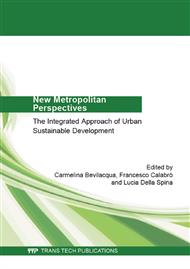p.303
p.314
p.323
p.330
p.338
p.344
p.351
p.356
p.364
Integrated Urban Regeneration: The Opportunity of Enhancing the Open Spaces
Abstract:
The paper, draws the attention of the debate a reflection on the possibility of developing, in some urban areas, strategies and actions for the regeneration and redevelopment of the city; bringing to the attention not only the improvement of the spatial and functional dimension of the rundown neighborhoods, but also of the social and environmental dimensions. The valorisation of these areas may benefit from the theory of Ecosystem Services [, which appears to be able to renew the traditional approaches, to land use planning from the perspective of urban metabolism [; in this regard are of great interest those forms of planning of degraded urban fringes that take into account the minimal standard of space and/or rural services by to each inhabitant in order to make an area sustainable. The contribution starts from careful analysis of the rural peri-urban areas of Tuscany, polarized between two apparently conflicting dynamics between them (use of land abandonment and agricultural soils), to develop a reflection about the possibility of experiencing urban regeneration processes that include in inside them, innovative forms for the design of open spaces, with the aim both to recover a portion of depressed urban areas both to create new public spaces, modeled according to the forms of multifunctional agriculture and identitarian landscape [. An urban regeneration directed not only to the built space, but also to the open space and to the promotion of effective projectuality through proper analysis of services, which could be offered by rural areas and serve needs expressed by residents.
Info:
Periodical:
Pages:
338-343
Citation:
Online since:
June 2014
Authors:
Permissions:
Share:
Citation:


